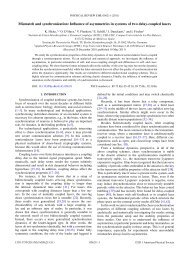DBI Analysis of Open String Bound States on Non-compact D-branes
DBI Analysis of Open String Bound States on Non-compact D-branes
DBI Analysis of Open String Bound States on Non-compact D-branes
You also want an ePaper? Increase the reach of your titles
YUMPU automatically turns print PDFs into web optimized ePapers that Google loves.
CHAPTER 4. CONFORMAL INVARIANCE 56where D (z ′ ) zstands for the Schwarzian derivative, 3D ( z ′) z = ∂ z (z ′ )∂z 3 (z ′ ) − 3 (2 ∂2z z ′) 2(∂ z z ′ ) 2 . (4.13)The important thing is that we are now faced with a c<strong>on</strong>formal anomaly c, <str<strong>on</strong>g>of</str<strong>on</strong>g>ten alsocalled central charge, a term that signals the breakdown <str<strong>on</strong>g>of</str<strong>on</strong>g> c<strong>on</strong>formal invariance forgeneral c<strong>on</strong>formal transformati<strong>on</strong>s in the quantum theory if c ≠ 0. The c<strong>on</strong>sequencehere<str<strong>on</strong>g>of</str<strong>on</strong>g> is that the trace <str<strong>on</strong>g>of</str<strong>on</strong>g> the energy-momentum tensor no l<strong>on</strong>ger vanishes, but nowbecomesT α α = − c12 R(2) , (4.14)with R (2) representing the Ricci scalar <str<strong>on</strong>g>of</str<strong>on</strong>g> the world sheet. This implies that we willrun into problems when c<strong>on</strong>sidering n<strong>on</strong>-flat world sheet space-times, or at least severerestricti<strong>on</strong>s as to the possible c<strong>on</strong>sistent c<strong>on</strong>figurati<strong>on</strong>s.On a final note for interested and/or intruiged parties, all <strong>on</strong>e could ever wish toknow about c<strong>on</strong>formal field theory, and then some, can be found in [4].4.2 <str<strong>on</strong>g>String</str<strong>on</strong>g> Theory vs. QFT vs. General RelativityRefreshing the Polyakov acti<strong>on</strong> we used in order to study the bos<strong>on</strong>ic string (Eq. 2.5),S σ = − 1 2 T ∫d 2 σ √ −hh αβ η µν ∂ α X µ ∂ β X ν ,we see that a possible generalizati<strong>on</strong> to curved backgrounds naturally imposes itself,namelyS g = − 1 ∫4πα ′ d 2 σ √ −hh αβ g µν (X)∂ α X µ ∂ β X ν , (4.15)where we have simply replaced the Minkwoskian metric with an arbitrary, n<strong>on</strong>-trivial,field-dependent metric. One might argue that this is actually using results before havingobtained them, as the g µν field came about by c<strong>on</strong>structing the spectrum <str<strong>on</strong>g>of</str<strong>on</strong>g> the quantizedclosed string (or if you prefer: is generated by the strings themselves), but it can beshown without great difficulty 4 by c<strong>on</strong>sidering perturbati<strong>on</strong>s around η µν that this acti<strong>on</strong>does indeed comply with the way the gravit<strong>on</strong> arises in string theory.That seems easy enough, but we have seen in the previous chapters that the bos<strong>on</strong>icstring theory, as well as the (NS,NS) sector <str<strong>on</strong>g>of</str<strong>on</strong>g> both Type II superstring theories c<strong>on</strong>tainnot <strong>on</strong>e, but three massless bos<strong>on</strong>ic fields: 5 the space-time metric g µν which we just3 Note that it seems like every<strong>on</strong>e uses their own little symbol to represent this functi<strong>on</strong>. We follow[14].4 You might ask yourself: “So why d<strong>on</strong>’t you do it here?” The answer is that this short dem<strong>on</strong>strati<strong>on</strong>deals with vertex operators, and hence string interacti<strong>on</strong>s, which the author <str<strong>on</strong>g>of</str<strong>on</strong>g> this thesis has purposfullyleft out <str<strong>on</strong>g>of</str<strong>on</strong>g> his writings.5 The Type II theories also c<strong>on</strong>tain massless fields in the other sectors as we saw <str<strong>on</strong>g>of</str<strong>on</strong>g> course, but thefields originating from the (NS,NS) sector are the <strong>on</strong>ly <strong>on</strong>es they have in comm<strong>on</strong> with each other, andwith the bos<strong>on</strong>ic theory.
















